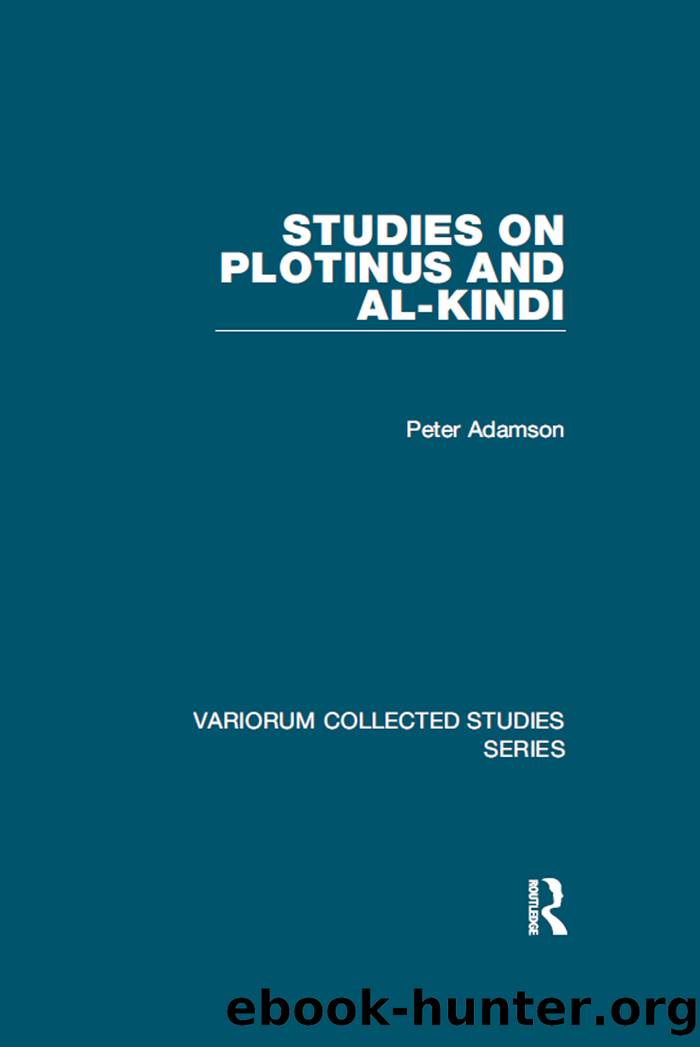Studies on Plotinus and Al-Kindi by Peter Adamson;

Author:Peter Adamson;
Language: eng
Format: epub
Publisher: Taylor & Francis (Unlimited)
Published: 2014-08-15T00:00:00+00:00
This is obviously the passage behind section [D] of the text cited above, which, to my knowledge, makes [D] the first known authentic fragment of Porphyryâs commentary on the Physics in Arabic.22 In light of this, it would seem that al-RÄzÄ« was rather well-informed about not only Aristotleâs Physics but also some of the Greek commentaries on the Physics; and it would seem that these commentators included Porphyry.23
IV: The Arabic context: the Baghdad Peripatetics
How did al-RÄzÄ« get his information? Well, as we saw above, Ibn al-NadÄ«m, himself a resident of 10?â century Baghdad (he died in either 385/995 or 388/998), knew of an Arabic version of Porphyryâs commentary on Physics I-IV, which would of course have included our text on II.8. And the Physics itself was well known to Arabic authors at the time. This is shown above all by the so-called Baghdad Physics,24 which is preserved in a unique manuscript held in Leiden. The manuscript contains a translation of the Physics by IsḥÄq ibn Ḥunayn, along with comments by several Christian members of the Baghdad school of Peripatetic philosophers. The most famous representative of the Peripatetic movement in Baghdad is the Muslim al-FÄrÄbÄ«, but for our purposes the crucial figures arc the Christian thinkers gathered around Yaḥya ibn âAdi, one of al-FÄrÄbÄ«âs students. Ibn âAdÄ« was also a student of the Christian AbÅ« Bishr MattÄ ibn YÅ«nus, and he devoted intensive philosophical activity to Christian theological writing as well as to more straightforward Aristotelian philosophical work.25 Ibn âAdÄ« and his school have been aptly compared in their aims and methods to the Alexandrian school of later Neoplatonists. Indeed their activity may be said to be part of a more or less continuous tradition of reading and commenting on Aristotle that stretches forward from the school of Ammonius. I want to argue now that al-RÄzÄ«âs discussion may well have been a response to the activities of the Baghdad school.
The Baghdad Physics is an edition of the Physics made by a third generation student of YaḥyÄ ibn âAdÄ« named AbÅ« âl-Ḥusayn al-Baá¹£rÄ«. AI-BasrÄ«âs version collates comments by Ibn âAdÄ« himself with notes from the lecture course of âAbÅ« âAIÄ« ibn al-Samh, a student of Ibn âAdÄ«âs.26 Of particular interest to us, of course, are the Baghdad philosopherâs comments on Book II. These include remarks by AbÅ« Bishr MattÄ, Ibn âAdÄ« and Ibn al-Samḥ. Arabic versions of comments by John Philoponus and, more occasionally, Alexander, are also included. So we are in a position to see that these philosophers were aware of Alexanderâs views on nature, and the senses in which it is analogous and disanalogous to art.27 One of the Alexander comments in the Baghdad Physics reads as follows:
Nature is not an efficient cause of what comes to be by chance, but rather deliberation and will are. For chance comes about through acts of will resulting from deliberation. Will is acquired and not natural, even if it is by his nature that man wills the goal of will,28 while art is external to the things; but as for the goal of nature and form, it is the same thing.
Download
This site does not store any files on its server. We only index and link to content provided by other sites. Please contact the content providers to delete copyright contents if any and email us, we'll remove relevant links or contents immediately.
Cecilia; Or, Memoirs of an Heiress — Volume 1 by Fanny Burney(32440)
Cecilia; Or, Memoirs of an Heiress — Volume 2 by Fanny Burney(31875)
Cecilia; Or, Memoirs of an Heiress — Volume 3 by Fanny Burney(31858)
The Great Music City by Andrea Baker(31539)
We're Going to Need More Wine by Gabrielle Union(18973)
All the Missing Girls by Megan Miranda(15599)
Pimp by Iceberg Slim(14399)
Bombshells: Glamour Girls of a Lifetime by Sullivan Steve(13979)
Talking to Strangers by Malcolm Gladwell(13233)
Norse Mythology by Gaiman Neil(13217)
Fifty Shades Freed by E L James(13163)
For the Love of Europe by Rick Steves(13134)
Mindhunter: Inside the FBI's Elite Serial Crime Unit by John E. Douglas & Mark Olshaker(9212)
Crazy Rich Asians by Kevin Kwan(9174)
The Lost Art of Listening by Michael P. Nichols(7412)
Enlightenment Now: The Case for Reason, Science, Humanism, and Progress by Steven Pinker(7243)
The Four Agreements by Don Miguel Ruiz(6641)
Bad Blood by John Carreyrou(6559)
Weapons of Math Destruction by Cathy O'Neil(6152)
